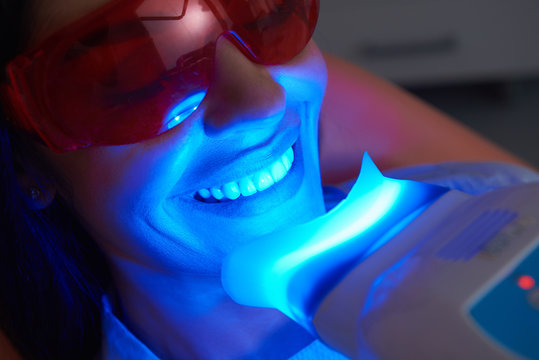


LASER stands for Light Amplification by the Stimulated Emission of Radiation. The instrument creates light energy in a very narrow and focused beam. This laser light produces a reaction when it hits tissue, allowing it to remove or shape the tissue. Lasers can make dental treatments more efficient, cost-effective, and comfortable for the patient.
Laser dentistry provides patients with a better experience and quality. Even though laser dentistry is mainly associated with cosmetic treatments, it is equally effective for preventative purposes. It potentially offers a more comfortable treatment option for a number of dental procedures involving hard or soft tissues compared to drills and other non-laser tools.
All lasers work by delivering energy in the form of light. When used for dental procedures,
the laser acts as a cutting instrument or a vaporiser of the tissue that it comes in contact
with. When used in teeth-whitening procedures, the laser acts as a heat source and enhances
the effect of tooth-bleaching agents.
Instead of needles and drills, laser dentistry uses Heat and light to treat Dental
infections. That’s why the procedure is less painful.
The word LASER is an abbreviation for Light Amplification by Stimulated Emission of
radiation.
The concept of lasers is based on Einstein’s theory of stimulated emission. Lasers are used
in a wide range of medical and cosmetic procedures. Recently it has received attention in
clinical dental settings. With minimal anaesthesia, lasers ablate the hard tissues.
Bacterial counts in root canals are also reduced with the help of laser treatment. There are
different ways by which lasers are used in dentistry. During surgical procedures of soft
tissues, good hemostasis can also be achieved with their use. The most common types are
carbon dioxide (CO2), diode, neodymium: yttrium– aluminum–garnet (Nd: YAG), and erbium:
yttrium–aluminum–garnet (Er: YAG) lasers. They are used for cavity preparation, tooth
whitening, gingival incisions, and other applications.
Lasers are categorized by various methods, however broadly, they are classified into two
categories – hard or soft tissue lasers. This is because some are too abrasive for soft
tissue while others aren’t abrasive enough for hard tissue. Some can be used interchangeably
if their wavelength allows it.
Hard Tissue Lasers in Dentistry
The essential use of this laser is to cut the teeth with exact precision. It cuts into the
teeth and bones with accuracy. This laser treatment is perfect during the cutting of the
tooth structure.
The wavelength from the intricate tissue laser is highly absorbable by hydroxyapatite.
Besides, the lasers include Erbium Chromium YSGG and Erbium YAG.
Hard tissue laser also helps in preparing or shaping the teeth with composite bonding. It
helps in the removal of small tooth structures and the healing of dental tear fillings.
Some common hard tissue procedures include:
Dental Soft Tissue Laser Procedures
Soft tissue lasers can highly absorb water and haemoglobin, making them suitable to treat
problems in the soft tissue. Likewise, the soft tissue lasers include Neodymium YAG with
diode lasers. It helps in killing the bacteria in the mouth and helps reactivate the growth
of the tissues.
Some common soft tissue procedures include:
You must be curious about what laser dentistry is used for. Well, there are a lot of dental
treatments that are being replaced by pain-free laser dental treatments like:
Removing benign tumours
Lasers can remove tumours from the palate, gums, and sides of the lips and cheeks through
pain- and suture-free methods.
Dental fillings
Local anaesthesia and traditional drills are often not needed with laser treatments. Lasers
can kill bacteria in a cavity, which can aid in the long-term health of a tooth.
Treating tooth sensitivity
Teeth that have sensitivity to hot and cold can be treated with dental lasers that seal
tubules on the tooth’s root.
Treating a “gummy smile”
Lasers are used to reshape gum tissue associated with a “gummy smile” in which the gums’
length covers much of the tooth.
Crown lengthening
This procedure reshapes both gum tissue and bone for healthier tooth structure, which helps
with placing restorations on the teeth.
Treating tongue frenulum attachment
Those with a thick or tight frenulum (the fold of skin under the front part of the tongue
that anchors to the mouth floor) may benefit from a laser frenectomy. This treatment helps
children whose restricted frenulum causes them to be tongue-tied, have difficulty
breastfeeding, or have a speech impediment.
Removing soft tissue folds
Lasers can remove soft tissue folds from ill-fitting dentures without pain or sutures.
Different laser treatments require different processes and approaches. It depends from case to case and patient to patient, how much the cost will be.
Our training vertical will start soon. Till then, you can join us as a trainee to learn various dentistry-related practices.
Q.1. What Is Laser Dentistry Used For?
To be specific, laser dentistry refers to light energy that is a thin beam of extremely
focused light, exposed to a particular tissue so that it can be moulded or eliminated from
the mouth. Throughout the world, laser dentistry is being used for conducting numerous
treatments, ranging from simple procedures to rather complex dental procedures.
Some of the most common treatments that are done with laser dentistry are:
Q.3. How Does Laser Dentistry Work?
Laser Dentistry is the way of the future. Based on modern medical science, a laser is a
device that emits a narrow and very intense beam of light that neither diffuses nor spreads
out. When focused at close range, these beams act on the tissue. Laser dentistry employs
this beam to shape or even remove soft or hard tissue.
Q.4. Is Laser Dentistry Better?
Laser dentistry can fix cavities without all the painful stuff. Just imagine getting rid of
that toothache and not hearing the sound of a drill in your sleep for weeks afterward.
It’s not just for cavities, either. Laser dentistry can treat anything from canker sores to
gum disease. It’s often a great option for kids too.